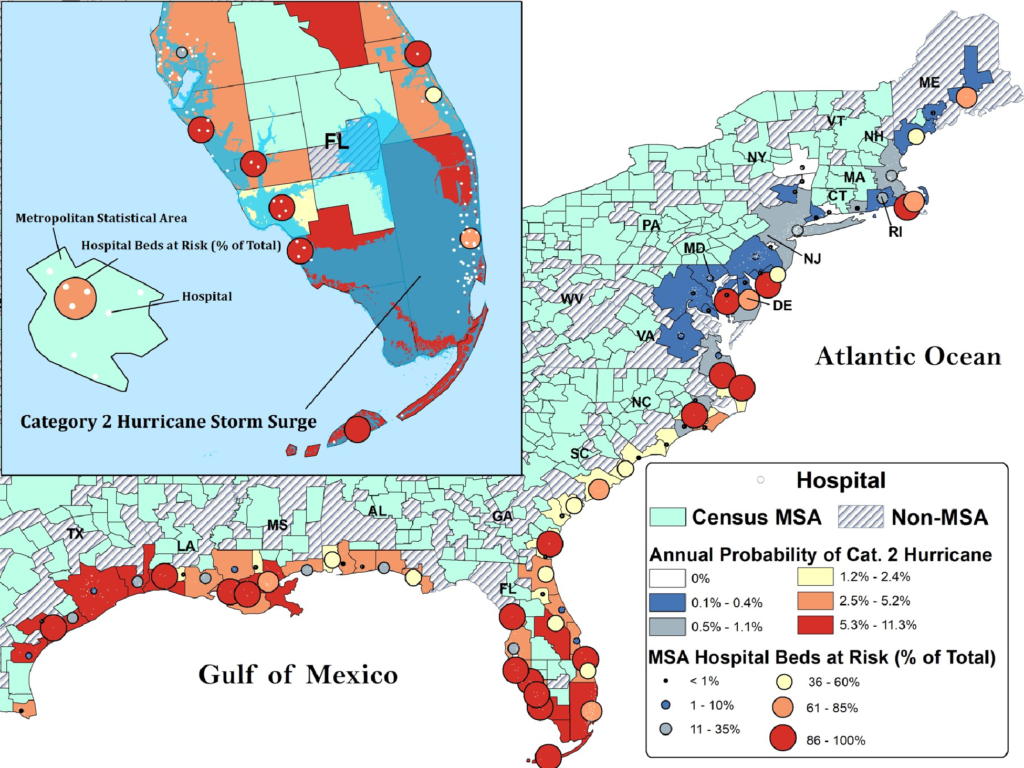
An ambulance is swamped on a flooded road in New Jersey during Hurricane Sandy. Even if hospitals are not flooded during a tropical storm, the roads to access them may be, limiting access to healthcare facilities. Credit: acarino/flickr
The first study to systematically investigate flooding risk to hospitals on the Atlantic and Gulf Coasts from Category 1-4 storms finds even relatively weak storms pose a serious flood risk to hospitals along the coast. Sea level rise expected in this century due to climate change increases the odds of hospital flooding by 22%, according to the study, which was published today in the AGU journal GeoHealth.
"We now have a better sense of which hospitals are likely to flood from a hurricane today and those that need to prepare for greater risks in the future," said senior author Dr. Aaron Bernstein, director of the Center for Climate, Health, and the Global Environment at Harvard University. "Hurricanes are expected to get more severe and may strike regions further north than in the past due to climate change. In places like my hometown of Boston, we can avoid crises that other hospitals have had to endure by learning from their experience and creating plans that build on best practices. But we must act now, before disaster strikes."
Researchers identified 682 acute care hospitals in 78 metropolitan areas located within 10 miles of the Atlantic and Gulf Coasts of the United States, covering a population just under 85 million people, or about 1 in 4 Americans. They found 25 of the 78 metro areas studied have half or more of their hospitals at risk of flooding from a Category 2 storm.
According to the study, Category 2 hurricanes significantly threaten access to hospital care in the Miami, New York City, Boston, Orlando and New Orleans metro areas, followed by several locations throughout Florida.
With sea level rise expected this century, the Baton Rouge, Virginia Beach, Corpus Christi, Philadelphia and Boston metro areas will see a more than a 90% increase in the number of beds at risk of flooding from a Category 2 storm.
Even if hospital buildings do not become flooded, the roads around them might, restricting or preventing access. In 18 metro areas, at least half of the roads within one mile of hospitals were at risk of flooding from a category 2 storm. Flooded roads have often been a major challenge to patient transfer during hurricanes as well as patient and staff access to hospitals after storms have passed.
"Our study shows that a large fraction of hospitals on the Atlantic and Gulf Coasts are at risk of flooding from relatively weak hurricanes and highlights the pressing need for infrastructure improvements to mitigate this risk," said Alexandra Taraborchia-Gast, lead author of the study and a family medicine physician. "Some hospitals and cities have already taken steps in this direction."

A new study finds in 25 of 78 metropolitan areas ("MSA" on this map), over half of the area's hospitals are at risk of flooding and reduced access during a Category 2 storm. The large red dots in this map denote metro areas where the highest fraction of hospital beds (86% to 100%) would face access issues during a Category 2 storm. Credit: GeoHealth/AGU
A model for hospital readiness
The Southeast Louisiana Veterans Health Care Center, built in 2016, provides a model for how coastal hospitals and health systems can improve their resilience to hurricanes, according to the study. It was designed to remain operational for seven days even if city utilities and infrastructure are compromised and features back-up fuel supplies, on-site sewage treatment facilities and sufficient accommodations for up to 1,000 staff and patients to shelter in place. Critical mechanical and electrical equipment as well as patient care areas are located at least 20 feet above the 100-year floodplain.
"However, not all hospitals have the resources to make these improvements and, perhaps more importantly, many do not have prior experience with flooding or awareness of their own flood risk. Climate change and sea level rise stand to increase flooding risk where hospitals may have less experience with hurricanes," Gast said. And, because of road-related risks, "healthcare resiliency to hurricanes extends beyond making changes to individual buildings and involves city-wide and regional coordination of care during storms and infrastructure investments."






